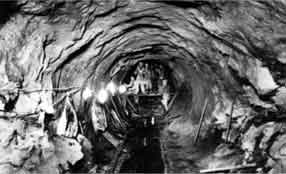Waterworks: Overview & history of the water system

The private enterprise “Vancouver Waterworks Company” was incorporated under a special act of the Provincial Legislature on the same day that the City of Vancouver was incorporated in 1886. Vancouver's first water supply system was installed by the Vancouver Waterworks Company between 1886 and 1889. Water was obtained from Capilano Creek in North Vancouver and delivered through 7 miles of riveted steel main which crossed under the first narrows. In the early 1890's the City acquired the private utility.
Capilano Creek continued to be the sole source of supply for seventeen years. However growth of the City and the low flows of Capilano Creek in summer made the development of other sources necessary. In 1908 the Seymour supply crossed the Second Narrows. At this time the need for storage on the south shore of Burrard inlet became apparent. In 1911 the City built the Little Mountain Reservoir.
In 1922 a report titled "On the Question of Joint Control of the Water Supply to the Cities and Municipalities on the Burrard Inlet" led to the formation of Greater Vancouver Water District (GVWD) between 1924 and 1926.
With the inclusion of New Westminster into the GVWD in 1931, the District obtained control of the Coquitlam Supply System. This system, like Vancouver's, was first developed by a private utility, then acquired by the City of New Westminster.
Between1930 and 1960 there was much development of the system, including:
- 1932/33 90 inch pressure tunnel constructed under First Narrows.
- 1948 Ten old 18 inch cast iron mains under Second Narrows paralleled with 48 inch main.
- 1950's Cleveland Dam constructed on Capilano Creek
- 1955 Kersland Reservoir constructed. Construction of 42 inch main to supply Richmond.
- 1961 Concrete and Earth-Fill Dam constructed at Seymour Falls.
By 1961 supply problems were becoming an issue. Due to increased demands from other members of the water district, pressures in Vancouver were dropping from year to year. At this time lawn sprinkling restrictions each summer was normal.
Because of these poor pressures, the City requested that the District undertake a study to establish future pressure zone boundaries within Vancouver and establish a program of capital construction for distribution feeder mains within the City. The study was begun in 1964. In 1966 the "Zones and Feeds Study" was completed. It resulted in the rearrangement of pressure zone boundaries and the construction of various supply mains and pumping improvements in both the City and GVWD systems.
[top]
The system at present
Domestic water systems work best in a pressure range between 40psi and 60psi. To supply water at acceptable pressures, Vancouver is divided into eight pressure zones. Each zone is supplied with water at a reasonable range of pressures within the zone. At low elevations where the pressure due to gravity would be unacceptably high the water is supplied through a valve which reduces the pressure (Pressure Reduction Valve or PRV)
As water in a pipe flows faster, frictional losses increase and water pressures go down. Vancouver obtains its water from GVRD pipes which also supply municipalities of Richmond, Delta etc. As growth in these Municipalities has occurred, flow through the mains has increased and pressures in Vancouver have dropped.
[top]